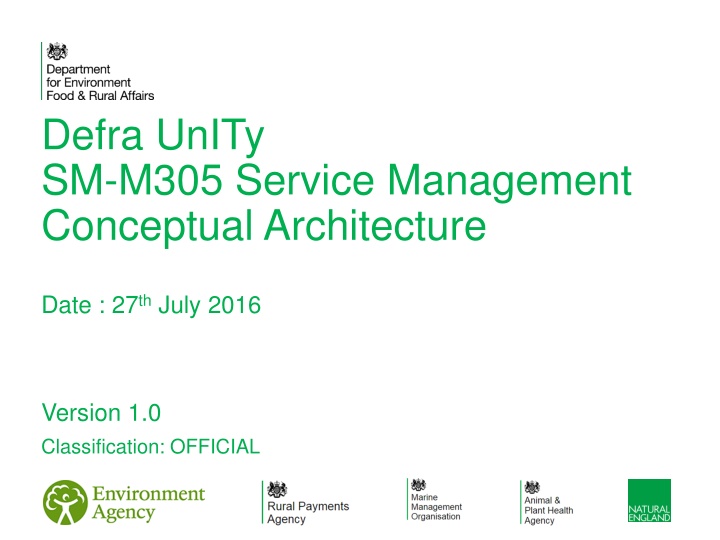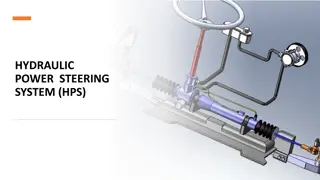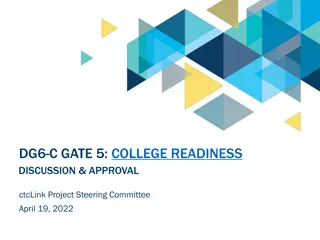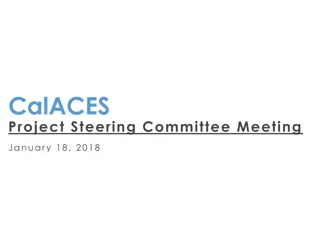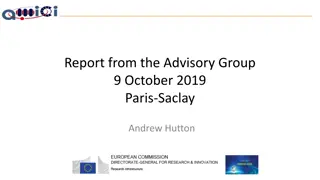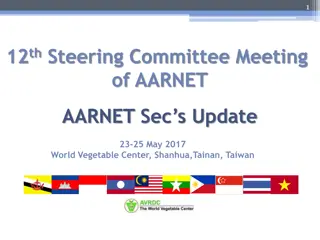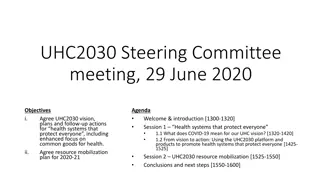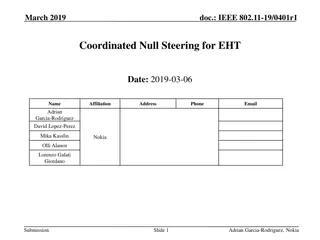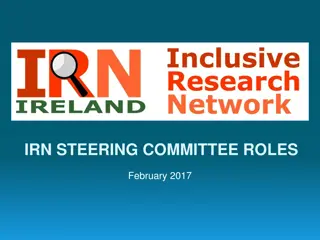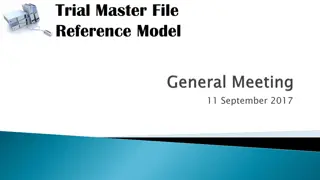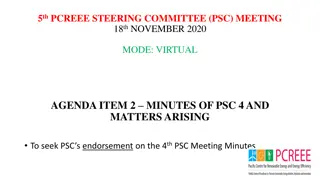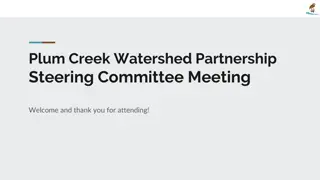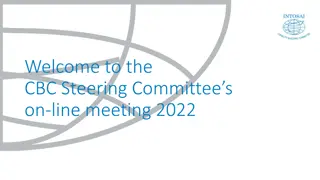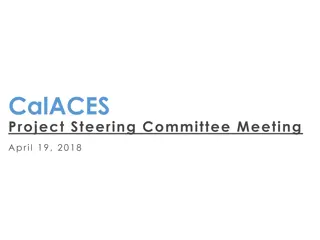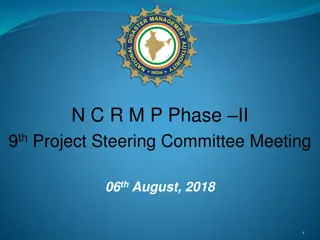Project Steering Committee Meeting Overview
This document provides a detailed overview of the Project Steering Committee Meeting held on April 18, 2019. It covers agenda review, action items approval, informational updates, application development progress, project management office activities, and DD&I status summaries.
Download Presentation

Please find below an Image/Link to download the presentation.
The content on the website is provided AS IS for your information and personal use only. It may not be sold, licensed, or shared on other websites without obtaining consent from the author.If you encounter any issues during the download, it is possible that the publisher has removed the file from their server.
You are allowed to download the files provided on this website for personal or commercial use, subject to the condition that they are used lawfully. All files are the property of their respective owners.
The content on the website is provided AS IS for your information and personal use only. It may not be sold, licensed, or shared on other websites without obtaining consent from the author.
E N D
Presentation Transcript
Defra UnITy SM-M305 Service Management Conceptual Architecture Date : 27th July 2016 Version 1.0 Classification: OFFICIAL
Service Management Objectives Area Service Management Programme Objectives Procurement Replace two major ICT contracts that are due to expire in 2017 and 2018 (re- procurement) Delivery Implement a function to manage and assure delivery of all UnITy work stream solutions Transition Low risk transition from the current contracts providing continuity of service, reliable and robust ICT, to allow the in scope organisations to discharge their front-line operational delivery and legislative obligations.. Service Model Implement a new single One Defra service model to replace business-aligned service models. Area Service Management Work Stream Objectives Procurement Complete four procurements, Consultancy Partner, Delivery Partner, Service Management toolset and Service Desk Delivery & Service Model Design and implement a common Service Management Operational Model capability Transition Implement in a phased approach, Initial Operations Capability, ITSM toolset and Service desk to achieve the Defra IT Service Model Programme scope derived from UnITy scope and SM proposition paper 2 - OFFICIAL
Service Management Scope Services Scope of Workstream Architecture Service Management Operational Model Defined the functional model and responsibilities of the Defra retained IT operational organisation, suppliers and service partners Initial Operational Capability Implement an Initial Operational Capability to provide a management solution for all agreed Defra pipeline projects, UnITy early deliverables and agreed Digital Transformation initiatives ITSM Tool Implement and configure an IT Service Management toolset to be used by all core suppliers Service Desk Integrate a Service Desk service into the overall service model and operational Service Management model Outsource Service Management IT services As an extended part of the Service Desk, Integrate a ITIL service delivery function into the overall architecture and operational Service Management model On-Boarding of Services On-Board in to the Defra Service Model new UnITy and Interim services that have completed their service readiness obligations Transition of Service Management Transition legacy IT Service Management provide by the incumbent suppliers to the Defra Service Model Integration of Defra initiatives (Digital Transformation) Cooperate with Digital transformation and any other programmes to implement supporting Service Management services 3 - OFFICIAL
Design Principles for Service Management Service Management design principles have been derived from the following: Services Scope of Workstream Architecture Work-stream scope UnITy BOARD PAPER - UnITy Programme Scope Proposition Paper UnITy Service Management Work-stream Proposition paper Architecture Principals Network Architecture Design Board - Interim Architecture Principles v0.4 Architecture Scope Technical Reference Model Taxonomy v0.12 Service Management Scope Service Management, High Level Target Operating Model 20th May 2016 4 - OFFICIAL
Service Management CMO Characteristics The current mode of operations to be replaced by the UnITy programme is based on two full outsource contracts, key elements of these contracts are; Independent Digital Data Technology Services (DDTS) & Corporate Information Services (CIS) outsource service via IBM & Capgemini Supplier provided Service Desk Life cycle management of IT services Operational management ITSM tools and process management Architecture management services Service Reporting Service Design and implementation Pipeline services coordinated by joint DDTS / CIS support Contractual relationship managed via Defra Rural Payments Agency (RPA) utilise IBM infrastructure services Business functions and application suppliers provide additional support and management services 5 - OFFICIAL
CMO Architecture Three IT service desks in operation today supporting delivery of incumbent EA, DEFRA and RPA services. 6 - OFFICIAL
TMO Characteristics The Transition Mode of Operations will introduce a Defra management and coordination function between the incumbent suppliers to provide a management interface for new services. Incumbent Suppliers (IBM, Capgemini) Service management and Service desks continue support The Defra Group Services, Initial Operational Capability (IOC) established Pipeline support service migrated to the IOC Service Management Delivery Partner Develop operational and management capability Phased development to match IOC demand ITSM development Provide interim resource to operate IOC Legacy supplier operational interface established ITSM IT Service Management toolset platform implemented Single point of reference and record for IOC activity Configuration to support IOC operation and supplier management 7 - OFFICIAL
TMO Architecture The proposed transition approach for service management will consist of 3 phases through an iterative approach to build the new organisation. DDTS/CIS Pipeline support Defra RPA) Business Desks Control Capgemini Services Delivery IBM Services The first transition phase - Initial Operating Capability (IOC) will run in parallel with current BAU operations and will support new pipeline services such as IDM and MDM. Service Desk Service Desk Service Management Toolset Service Management Toolset 1st Line Defra Group Services - Initial Operating Capability 2nd line Core Service Operations Core Service Operations Delivery 3rd line Control Subsequently the IOC will be scaled up to take on service management responsibility for early UnITy services such as Managed Print. Core Suppliers Core Suppliers Transition UnITy Service Suppliers 8 - OFFICIAL
FMO Characteristics The Final Mode of operations moves to a single operational management model coordinating multiple suppliers via common processes and a single ITSM toolset End User Single point of contact via Service Desk Service Request catalogue User tools, Chat, self service, Knowledge portal Service Desk Partner provided service Core ITIL process execution ITSM Tool Orchestration of all processes Dashboards, reports and service views Operational model Service Management Operational model organisation resourced by Defra & Partners Suppliers UnITy suppliers on-boarded and delivering services Commodity & non UnITy suppliers integrated 9 - OFFICIAL
FMO Architecture A thin retained organisation who owns and controls the overall service management model (processes, tools and integration) as well as supporting a small number of non- commodity services. Defra Retained - Control, Management and Governance Service Desk 1st Line Defra Service Management Toolset Core Service Operations 2nd line A new Service Desk supplier providing a single point of contact for all End Users and providing core service operational management for an agreed set of processes. Defra Group (IT) Retained Operations Core UnITy Suppliers 3rd line Commodity suppliers Operational Interface Interface Non-Commodity suppliers (IDM, UC) Collaboration 10 - OFFICIAL
Service Management Operational Model Service Management Operating Model Defra End Users Service Desk Service Management Interface Service Performance and Governance Request Fulfilment and Access management Supplier Services Incident Management Major Incident Management Problem Management Service Desk Strategy & Planning Service Management Control Service Architecture Policies and Standards Financial Service Service Strategy & Planning Service Governance and Assurance Vendor and Contract Management Operational Risk Management Portfolio Management Management for IT Services Measurement and Reporting Demand Management Service Design Service Transition Operate Governance Enterprise Architecture Service Operations Management Transition Planning and Support Service Asset and Configuration Change Evaluation and Management Operational Governance Capacity Management Availability Management ITSCM Business Relationship Service Process Control and Management Event Management Release and Deployment Management Information Security Strategy Service Level Management Service Catalogue Management IT Security Management Knowledge Management Environment Management Operational Security Management Programme Management ITSM Tooling Design and Interface Service Design Management Deployed Service Architecture Service Validation and Testing Service Acceptance CSI Risk Management and Compliance Suppliers EUE Managed Print Service Hosting & AMS Connectivity Internal Supply Teams Service Management Interface Service Management Interface Service Management Interface Service Management Interface Service Management Interface Service Performance and Governance Service Performance and Governance Service Performance and Governance Service Performance and Governance Service Performance and Governance Supplier Services Supplier Services Supplier Services Supplier Services Supplier Services 11 OFFICIAL
Service Catalogue The Service Catalogue publishes IT services defining the functional scope, performance and governance model relating to all services provided to end users or business functions. The services will consume the functional capabilities of the Service Register. Service grouping: Functional services (Knowledge worker solution) Technical Service (Vm s, site connectivity) Operational Services (Moves, Changes, new users) Service Attributes Hours of service Availability Band Priority criteria mapped to Resolution/response matrix Catalogue service definition For each service a catalogue service definition will be created as per the agreed template 12 - OFFICIAL
Service Level monitoring and compliance Service SLA monitoring of catalogue services Usage, fulfilment targets and performance against SLA Compliance to service obligations for application & infrastructure services Service Delivery against SLA ITSM process execution Incidents Requests Process execution Catalogue services Service performance (Availability, Resolution, Fulfilment) Supplier contribution, Supplier performance Service component Process compliance 13 - OFFICIAL
Service performance reporting presentation (1 of 2) Performance dash boards Business and Service performance view Adhoc reporting via the ITSM toolset Business context views Defra group performance Defra business unit reporting and performance SLA compliance OLA performance Financial Formatted paper reports Reports for distribution to non ITSM users 14 - OFFICIAL
Service performance reporting presentation (2 of 2) Service suppliers will deliver service to defined contractual levels and be measured against SLA & KPI performance metrics via the ITSM toolset. End User & Technical Services may comprise of a number of contributing supplier services. Therefore, the service and performance levels offered to Defra must take account of the performance capabilities of the contributing services A strategy for End User & Technical Business services will be developed through consultation with relevant stakeholders and introduced through the IOC. The UnITy ITSM tool provides a platform via a layered approach to service definition that could support definition of a Business Services Catalogue by mapping IT services to business functions, processes and operational capabilities. The Business Service Catalogue is outside the scope of UnITy. 15 - OFFICIAL
Service Desk & ITIL Services A new single Service Desk service will be procured via a specialist supplier who will provide the resources and systems to support delivery of the Service Desk service using the Defra ITSM toolset and process model. The service desk will: Use the Defra ITSM toolset Use supplier provided tools and systems to resolve incidents at first contact and fulfil standard requests Provide a single point of contact for all End Users, supplier and support functions. Orchestrate, process management and delivery activity as detailed in the Defra process model A Defra common core process set will be used by all core suppliers 16 - OFFICIAL
TOM Defra End User interfaces Interface Summary A web presented catalogue of product and services that can be filtered to show only relevant items for defined user groups. Service Request Catalogue Provide descriptions, supplementary information relevant to the content. Shopping basket to select and request and drive approvals. Provide fulfilment status information Web presented method to raise Requests and Incidents via a structured form to constrain and aid the users input End User portal Provide fulfilment/ resolution status information Web presented method to search a Knowledgebase Self help An interface to enable user to self-serve standard request or resolutions Orchestration Web presented chat interface with ability to generate Incidents/Requests from the chat content Ability to push notifications to all or groups of users Chat Notifications Send status/information emails Email Web presented service status portal Status Method to generate satisfaction surveys and format the request with information relevant to the service provided Customer Satisfaction 17 - OFFICIAL
IT Service Management toolset The ITSM toolset will be provide by a service tooling platform supplier specialist. The toolset will be used by all supplier for the core processes Interfaces will be provided for: Event Management Configuration Management Service Catalogue orchestration The tool will provide as a minimum: ITIL Process Orchestration Single point of record for all processes Configuration Management System (CMDB) federated to suppliers CMDBs Monitor SLA/OLA performance via process execution API to support data & process integration with supporting suppliers 20 OFFICIAL
Supporting material Annex A 19 - OFFICIAL
ITSM Event Monitoring ITSM Event Monitoring Interface Defra UnITy Service Supplier Defra Group IT Supplier event monitoring correlation engine SI Supplier Service Monitoring soliution Automation Event Status Correlation Incident Interface Notifications ITSM ITSM Toolset solution ITIL Process orchestration and single point of record Status Web API interface call End Users Notification Supplier Solution Service Delivery End User portal Supplier Service/ Operational Management Function Status Manual Incident generation via direct ITSM access (Sharepoint) exchange Supplier portal data Service Integration may implement a Defra Service Correlation system to monitor UnITy service Impact (This is currently not in scope) Defra Group Retained IT function Service Management Artefacts store ITSM solution shall support: Monitor the availability and performance of there services by either automated systems or operational process. Where a service impacting event is detected, raise an Incident record within the Defra Group ITSM tool. Record the Event start time as the Incident start time. Execute this via an automated API interface, direct access to the system or contact with the Service Desk The Incident will record the classification and level of Priority and Impact which will set the SLA/KPI monitor 20 - OFFICIAL
ITSM Configuration Management ITSM Configuration Management Defra UnITy Service Supplier Defra Group IT Configuration Defra CMDB CI Data Delivery interface ITSM ITSM Toolset solution Configuration management system * CMDB Defra Data CMDB Import API End Users Supplier Solution Service Delivery End User portal Supplier Configuration Management systems CI Data Visability Inventory Manual Configuration Maintenance CMDB Inventory & CI Discovery tools Attributes (Sharepoint) exchange Supplier portal data ITSM solution shall support: Define and agree on the scope and level of detail for configuration management (i.e., which services, assets and infrastructure configurable items to include). Identify and classify configuration items for population into the repository. Regularly identify all changes to configuration items. Identify status changes of configuration items and report against the baseline. Periodically verify live configuration items against the configuration repository by comparing physical and logical configurations and using appropriate discovery tools, as required. Defra Group Retained IT function Service Management Artefacts store 21 - OFFICIAL
ITSM Incident Management ITSM Incident Management Defra UnITy Service Supplier Defra Group IT Updates Status Automation Incident Interafce Notifications ITSM Suppliers ITSM Toolset Activity ITSM Toolset solution ITIL Process orchestration and single point of record End Users Supplier Service/ Operational Management Function Supplier Solution Service Delivery Updates End User portal Status Log update and resolve direct into Defra Group ITSM Updates Suppliers Service Desk Events (Sharepoint) exchange Supplier portal data Defra Group Retained IT function Service Management Artefacts store ITSM solution shall support: Working with Defra define incident classification and prioritisation schemes and criteria for problem registration, to ensure consistent approaches for handling, informing users about and conducting trend analysis in relation to their services Log all incidents, recording all relevant information so that they can be handled effectively and a full historical record can be maintained. Identify and describe relevant symptoms to establish the most probable causes, of the incidents. Reference available knowledge resources (including known errors and problems) to identify possible incident resolutions (temporary workarounds and/or permanent solutions). Select and apply the most appropriate incident resolutions (temporary workaround and/ or permanent solution). Verify with the affected users (if agreed on) that the incident has been satisfactory resolved. Monitor and track incident escalations and resolutions to progress towards resolution or completion. 22 - OFFICIAL
ITSM Availability & Capacity Management ITSM Availability & Capacity Reporting Defra UnITy Service Supplier Defra Group IT Consolidated Information Automation Data Interface Supplier ITSM toolset ITSM SI Enterprise Deployed Architecture Management ITSM Toolset solution ITIL Process orchestration and single point of record Interogate End Users Suppliers on system presentati Supplier Solution Service Information Delivery End User portal Consolidated Information Service Management tools Performance Data Defra Group Retained IT function Reports and supporting data (Sharepoint) exchange Supplier portal data ITSM solution shall support: Service Management Artefacts store Published report Working with Defra consider the following (current and forecasted) in the assessment of availability, performance and capacity of services and resources: Defra Group requirements, business priorities, business objectives, budget impact, resource utilisation, IT capabilities and industry trends. Service Integration consume all Availability, Capacity and performance data to inform its Enterprise view of the deployed architecture, application and service platforms Review availability and capacity implications of service trend analysis. Establish a process for gathering data to provide management with monitoring and reporting information for availability, performance and capacity workload of all information-related resources. Obtain guidance from vendor product manuals to ensure an appropriate level of performance availability for peak processing and workloads. 23 - OFFICIAL
ITSM Change Management ITSM Change Management Defra UnITy Service Supplier Defra Group IT SI Deployed Architecture Management Changes Automation Event Change Suppliers ITSM Toolset Interface Notifications ITSM ITSM Toolset solution ITIL Process orchestration and single point of record Raise & update Changes End Users Approvals Supplier Change management function Supplier Solution Service Delivery End User portal Manual Raise & update Changes Suppliers Service Desk Status Status (Sharepoint) exchange Supplier portal data Defra Group Retained IT function ITSM solution shall support: Use Defra s formal change requests to enable business process owners and IT to request changes to supplier Services. Service Management Artefacts store SI Deployed Architecture Management have responsibility of Enterprise impact of Change, support Change management Make sure that all such changes arise only through the Defra change request management process. Ensure that a documented procedure exists to declare, assess, give preliminary approval, authorise after the change and record an emergency change. Categorise change requests according Defra Groups policy (e.g., rejected, approved but not yet initiated, approved and in process, and closed). Include changes to documentation (e.g., business and IT operational procedures, business continuity and disaster recovery documentation, configuration information, application documentation, help screens, and training materials) within the change management procedure as an integral part of the change. 24 - OFFICIAL
ITSM Service Catalogue ITSM IT Service Catalogue Defra UnITy Service Supplier Defra Group IT Automation Interface ITSM product catalogue Service and ITSM Toolset solution ITIL Process orchestration and single point of record Service Capability End Users Requests Supplier Service Solution Delivery Supplier Service Design function Status (Sharepoint) Supplier service solution definitions exchange Supplier portal data Defra Group Retained IT function ITSM solution shall support: Publish in catalogues relevant live IT-enabled services, service packages and service level options from the portfolio. Service Management Artefacts store Continually ensure that the service components in the portfolio and the related service catalogues are complete and up to date. Draft customer service agreements based on the services, service packages and service level options in the relevant service catalogues. Determine, agree on and document internal operational agreements to underpin the customer service agreements, if applicable. Define service catalogues for relevant internal and external target groups based on business requirements. 25 - OFFICIAL
ITSM Service Performance Management ITSM Real-time Service Performance Defra UnITy Service Supplier Defra Group IT SI Enterprise performance management System Interogate Automation Status Status Suppliers Service portal Interface Notifications ITSM ITSM Toolset solution ITIL Process orchestration and single point of record End Users Suppliers Service management function Supplier Solution Service Delivery End User portal Status Update Defra ITSM system Suppliers Service Desk Notification (Sharepoint) exchange Supplier portal data Service Integration may Implement a Enterprise performance monitoring system. Currently this is not within UnITy scope Defra Group Retained IT function Service Management Artefacts store ITSM solution shall support: Monitor the performance Defra published Services in near real-time based on the activity logged with the ITSM toolset. Warn and escalate to defined stakeholders where breaches may occur Monitor and show the performance of suppliers against the agreed OLA s and there contracted SLA s 26 - OFFICIAL
ITSM Reporting ITSM Period Service Reports Defra UnITy Service Supplier Defra Group IT Automation Information Data Supplier Service Portal Interface Supplier ITSM system ITSM ITSM Toolset solution ITIL Process orchestration and single point of record Status End Users Notification Supplier Solution Service Delivery End User portal Status Supplier IT Service Management Function (Sharepoint) exchange Provide formatted reports Supplier portal data Defra Group Retained IT function Service Management Artefacts store ITSM solution shall support: Running report queries to generate data to compile service performance reports. Publishing formatted reports from Defra and supporting data provided by underpinning service suppliers Providing Service Status and contractual performance dashboards Support the calculation of Supplier Service credits regimes Publish reports 27 - OFFICIAL
ITSM Request Fulfilment ITSM Service Request Fulfilment Defra UnITy Service Supplier Defra Group IT Supplier ITSM toolset Event Task requests Tasks Automation Supplier orchestration system Request Interface Notifications ITSM Orchestration initiation ITSM Toolset solution ITIL Process orchestration and single point of record Status information End Users Notification Supplier Solution Service Delivery End User portal Suppliers log and progress Requests within the Defra ITSM system Status Supplier Service Desk Status (Sharepoint) exchange Supplier portal data Defra Group Retained IT function Service Management Artefacts store ITSM solution shall support: Working with Defra define service request classification and prioritisation schemes to ensure consistent approaches for handling, informing users about and conducting trend analysis. Log all service requests, recording all relevant information so that they can be handled effectively and a full historical record can be maintained. Verify entitlement for service requests using, where possible, a predefined process flow and standard changes. Verify with the end users (if agreed on) that the service request has been satisfactory fulfilled. Monitor and track request handling procedures to progress towards resolution or completion. 28 - OFFICIAL
Principles of Operation Supplier Integration Four levels of Supplier functional interface: Use Unity Work-stream supplier will utilise the Defra native ITSM tool and conform and contribute to standard operational processes. Integrate To supplement Use suppliers may use their existing ITSM tool solution, but will integrate and contribute via a technical interface for key process data and configuration. Interface The Service Management function will through agreed process interfaces, replicate key process data and configuration in to the UnITy ITSM solution. Exclude Suppliers who offer functional services will prescribed services solutions with little or no alignment to our Service Management model e.g. Microsoft. The Service Management function will perform the integration, limited to the provided interface. 29 - OFFICIAL
Supplier Engagement model example Software Delivery Life Cycle example of engagement by suppliers in Service Management process. Core suppliers follow integrated process model and comply to manage risk for service delivery Web Ops team engage at a level that support their way of working and manages the risk WebOps Core UnITy Supplier Defra Group (IT) Service Management Agile Development support team Service Desk Online Requests Core UnITy Suppliers Core Supplier Change deployment of software update WebOps Team make confing changes to application Standard Change Request Notify via Std Change request Service Management operational activity Raise Change request Change details Impact assessment Change Evaluation Web Ops operational and development activity to progress and deliver their service outcomes Release and development activity Status Notify schedule Core suppliers Service delivery organisation and partners maintain and deliver their service to contractual levels of performance and quality Status Validation and test Deployment Conformation Scheduling data Configuration update Close Notification 30 - OFFICIAL
SMOM - Operational Products The following are expected to be produced to support the implementation of the Service Management Operating Model Principles, policies Are the vehicle to translate the desired behaviour into practical guidance for day-to-day management. Processes Describe an organised set of practices and activities to achieve certain objectives and produce a set of outputs in support of achieving overall IT-related goals. Functional Organisational structures Who does what, interface to whom. Information to support SM delivery All information produced and used by the enterprise to enable services to be managed and delivered. Catalogue of Services, infrastructure and applications Including the infrastructure, technology and applications that provide the enterprise with information technology processing and services. People skills and competencies Identify the attributes required for successful completion of all activities and for making correct decisions and taking corrective actions. 31 - OFFICIAL
TOM Service Desk Element Defra Retained responsibility Supplier responsibility Incident Operate and monitor an ITIL aligned Incident process Use the Defra Process and ITSM toolset Major Incident Operate and monitor an ITIL aligned Major Incident process Use the Defra Process and ITSM toolset Problem Operate and monitor an ITIL aligned Problem process Use the Defra Process and ITSM toolset, contribute to solution development. Define fulfilment tasks within the Defra ITSM tool and operate the agreed OLA Request fulfilment Ability to initiate automated tools execution or activity and pre- defined tasks executed to an defined plan. Operate and monitor an ITIL aligned Request process Enable third parties to access via an interface operational management tools and systems to enable management of their services Service Management interface Provide access to operational tools and systems, controlled privileged access, RTO, logs etc. Service Performance and Governance Document and agree measurement method for all SLA/OLA s Enable definition and monitoring of service metrics, KPI s, SLA s Supplier services Deliver services to defined levels of performance, capacity and availability Deliver services as per contract 32 - OFFICIAL
TOM Service Management Control Element Defra Retained responsibility Supplier responsibility Service strategy & planning Maintain and develop the Service strategy. Collaborate to support development and offer innovation opportunities Service architecture policies and standards Create and maintain all Policies, define standards Comply with and demonstrate compliance Service Governance and assurance Define and operate Operational Governance structure Collaborate with Defra, support activity Vendor contract management Manage the interface with all IT service suppliers Cooperate with the IT Vendor management function Financial management for IT Services Provide conformation to Defra finance on consumption of services Provide granularity of data required to support invoice approvals Service Measurement and reporting Correlate data from suppliers to create Defra service management reports, dashboards, scorecards. Calculate performance of suppliers and services. Provide service performance reports, supporting data and where relevant access to monitoring/performance tools. Operational Risk management Manage the impact of Risk associated with IT services Manage Risk to service delivery, engage with the overarching Defra Risk management 33 - OFFICIAL
TOM Service Design Element Defra Retained responsibility Supplier responsibility Capacity Management Availability Management Manage and ensure necessary capacity is available to deliver all Defra IT service Maintain end to end service availability, optimisation of supporting supplier service performance. Manage and ensure necessary capacity is available to deliver supplied services Ensure services perform to contracted Availability target, provide information to Defra to support end to end Availability ITSCM Orchestrate and record activity to invoke continuity solutions Provide Service management data to support process. Monitor performance against defined levels provide warnings of potential breach Provide life cycle management of catalogue services from design through to retirement. Maintain a portfolio of End user, business, technical and operational services Orchestrate activity to address Security Incidents. Record security incidents and activity relating to there resolution. Deliver the ITSM tool, ensuring its availability and suppliers operational process requirements are maintained. Cooperate with Defra to test and implement Service continuity solutions. Manage Service delivery performance, provide information to Defra Service Level Management Service Catalogue Management IT Security Management Cooperate to publish services in the Defra Service Catalogue Comply with Defra security policy ITSM Tooling Design and Interface Maintain any supplier interfaces,. Contribute to the development, improvement of ITSM processes and configuration Address the requirements of the acceptance into service. Service Design Management End to end Service Design for all services published via the Service catalogue assuring acceptance into service Deployed Service Architecture Work with the Defra Service Integration function which will support for resolution or investigation assistance by orchestrating suppliers to technically functions Provide tools, systems and access necessary to enable authorised suppliers to manage and maintain end to end service 34
TOM Service Transition Element Defra Retained responsibility Supplier responsibility Transition Planning and Support Responsible for Service transition planning, scheduling and execution Support Defra in all activities relating to suppliers services Service Asset and Configuration Provide a Configuration management system including a CMDB, verify and audit CMS system. Provide an interface to suppliers configuration tools. Support the Change management process Provide the CMS to support the suppliers operational and management activates. Interface with the Defra ITSM CMS synchronise agreed CI s & attributes Use the Defra Change management processes and ITSM tool. Change Evaluation and Management Release and Deployment Management Knowledge Management Support the Release and deployment management process Comply with the Defra Release policy and processes Provide a searchable Knowledge base capable of sorting information on new services Create and maintain site and environment policies Create an maintain and publish knowledge articles in the Defra KM system Environment Management Comply with Defra site and environment policy Service Validation and Testing Assure testing Create test plans and perform tests 35 - OFFICIAL
TOM Operations Element Defra Retained responsibility Supplier responsibility Service Operations Management Provide a method to Orchestrate, record all operational activity performed by suppliers and support functions. Perform operational processes in line with operational procedures. Event Management Provide an interface to receive qualified events from external systems. Correlate the events impact on published Defra services. Classify and record events as Incidents Provide Service management data to support process Notify Defra of service impacting events Operational Security Management Comply with Security policy CSI Prioritise and direct CSI activity. Provide Service management data to support process Cooperate with Defra to support CSI activity Orchestrate and record activity addressing CSI objectives 36 - OFFICIAL
TOM Governance Element Defra Retained responsibility Supplier responsibility Operational Governance Provide Service management data to support process Cooperate with Defra Operational Governance Service Process Control and Management Provide a method to orchestrate and record and report on activity associated with process control Cooperate with Defra Service Process Control and Management 37 - OFFICIAL
TOM Strategy & Planning Element Defra Retained responsibility Supplier responsibility Portfolio Management Create and maintain the Portfolio management policy. Support Defra in delivery of Portfolio management Demand Management Provide Service management data to support process Provide Service management data to support process Enterprise Architecture Business Relationship Provide Service management data to support process Record the relationships between business entities, services, functions and service levels Provide a method to orchestrate and record and report on activity associated with business relationships Provide Service management data to support process Information Security Strategy Cooperate with Defra to maintain Information Security Strategy Programme Management Provide Service management data to support process Risk Management and Compliance Provide Service management data to support process 38 - OFFICIAL
TOM Suppliers Element Defra Retained responsibility Supplier responsibility Interface Provide an interface to enable ITSM systems to be integrated enabling exchange of data in near real-time for the core processes Service Performance Provide a solution to enable individual supplier performance to be recorded, monitored and reported on 39 - OFFICIAL
Dependencies Summary Responsible Workstream Architecture Delegated Scope All work-streams Provide service specific management tools, delivery/fulfilment processes necessary to operate a specific service. Service Integration Deliver service/solution architecture, design, integration and deployment to enable a service to perform to a defined performance, availability targets and have all necessary management and deployment capability. Service Integration Provide deployed architecture management, operation, maintenance and support Service Integration Ensure end to end services are capable of delivering the required levels of performance and functionality. All work-streams Creation of the Service Design for work-stream UnITy services All work-streams Provide service introduction, migration and transition activity required to implement any service under the TMO SM model to comply with the SM Service Readiness requirements. 40 - OFFICIAL
Design Principles for Service Management Services Scope of Workstream Architecture Multi-supplier co-ordination is Defra responsibility Defra will be accountable for multi-supplier co-ordination across all life cycle stages and for all processes. Defra provide vendor and commercial management Defra will be accountable for all vendor and commercial management. Supplier service performance Defra will be accountable for IT service performance across all suppliers Assurance for commodity services Defra will provide an assurance role for the management and delivery of the majority of commodity based services. Active management and delivery of non-commodity Defra will take a more active role in the management and delivery of non-commodity based services. Multi Supplier service and system integration will be provided by the retained IT origination Retained organisation is accountable for the design, delivery and performance of all end to end Services supported by each supplier Service Catalogue is co-ordinated and managed by the retained IT organisation supported by the suppliers Provides central view of all supplier services (including service level measures) presented via a single portal Derived from UnITy SM proposition paper 41 - OFFICIAL
Design Principles for Service Management Services Scope of Workstream Architecture Service Design through to Service Acceptance is a retained IT function responsibility supported by all suppliers Overall accountability for all services remains with the retained organisation, with suppliers providing information, deploying and operating their service according to their contract. A central view is maintained of asset and configuration information for all services. Authority will design and provide a central Configuration Management System which suppliers will interface to, populate, update and maintain. Change, release and deployment will need to be managed by the retained IT organisation A single IT supply chain forward schedule of change/release will be managed by the retained organisation supported by each supplier ensuring that releases can be managed in the most beneficial way for the business, managing conflict and ensuring that accountability is retained Knowledge Management will be co-ordinated and managed by the retained IT organisation with knowledge information provided by suppliers A central Knowledge Base will be provided by the Authority with Knowledge information provided and updated by suppliers for their services which will be made available to users, Service Desk and suppliers Service Continuity planning is managed by the retained IT organisation for all services End to end ITSCM plans for all commodity- and non-commodity services will be managed by the retained organisation 42 - OFFICIAL
Guardrails Architectural Principles Principle Rational Implications ITSM as SaaS Supplier access simplified Follows core principles Limitation on solution that are delivered as SaaS ITSM variable Per seat Licencing Usage costs linked to actual usage May exclude framework service Defra own the ITSM tool, core supplier use it Intellectual property, management control retained Impact on suppliers standard service models Common core ITSM processes operated by all Single view of service performance, management control, Impact on suppliers standard service models Defra retained IT organisation to be accountable for all service delivery Proposition Paper direction Management & risk and governance control Resources and skill required to operate the functions Out-Source Service desk and commodity management Proposition Paper direction Leverage industry good practice Supplier and interface to be managed Defra implement an interim Service capability Support migration transition, minimise the dependency on incumbents Incumbents cooperation required 43 - OFFICIAL
Sustainability approach The Service Management Architecture views will address sustainability impacts of its service model. Processes will be optimised to minimise the impact where possible via the use of tools, self help, knowledge and remote support. Additionally, consideration will be given to ensure elements of the solution such as the Service Desk consider: Staffing of service desks will be fair and in accordance with ILO best practice, Mitigate any reputational risk to Defra of these arrangements being exploitative e.g. long shifts without breaks, access to facilities, diversity, fair wages (living wage in UK ) 44 - OFFICIAL
Input Requirements scope Requirements from Defra that drive the scope and structure of the IT services and supporting supplier services. Existing Service Replace existing service scope Frameworks (ITIL, COBIT, Togaf) Good practice frameworks Service Supplier Business services Governance Management control Assurance Business needs SLA s Priority Capacity Availability Performance Transitional IOC 45 - OFFICIAL
Operational Requirements approach For each of the Service Management Model elements the following will be defined: Process Description Process Purpose statement IT Service goals related metrics Process goals related metrics Functional responsibilities (RACSI) Management practices Activities Inputs Outputs 46 - OFFICIAL
